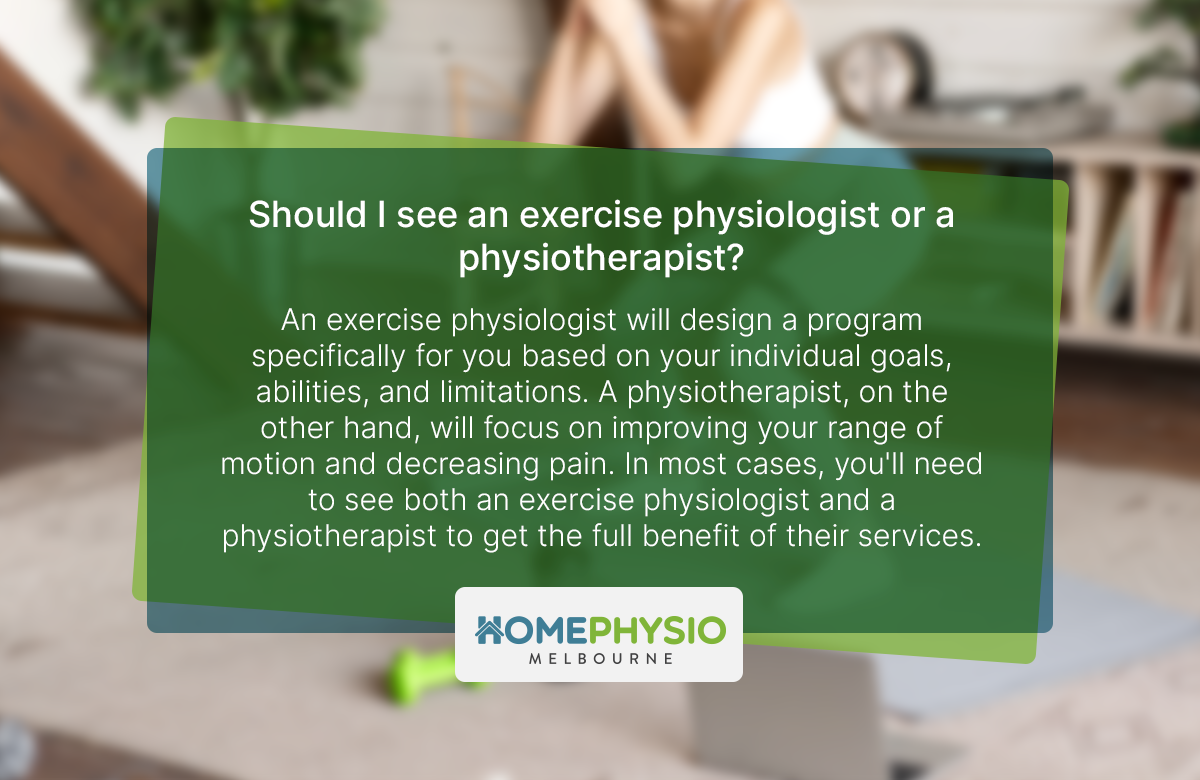While both exercise physiologists and physiotherapists are allied health professionals with the same end goal of improving a patient’s quality of life, the treatment methods and conditions they see are quite different.
Exercise physiologists and physiotherapists strive to provide high-quality care that improves physical function, health, and wellness. However, because both professions can work in a wide range of settings, it is understandable that there is some confusion between the two.
So, how do we distinguish between the two?
Distinct characteristics of exercise physiology
Clinical exercise interventions are the primary treatment modality used by exercise physiologists. A strong emphasis is also placed on behavioural change and self-management concepts.
They specialise in teaching lifestyle modification techniques and providing lifestyle education to individuals with various chronic health conditions. This promotes better health and wellness and reduces their risk of morbidity. These chronic conditions include heart disease, cancer recovery, respiratory issues, mental health issues and diabetes, among others.
Exercise physiologists will collaborate with you to determine the how and why of your situation so that both can be addressed and future occurrences can be avoided.
Exercise physiologists can also work with you to create individually tailored exercise plans to help you achieve your weight loss or maintenance goals or create a strength and conditioning programme to improve your athletic performance.
Distinct characteristics of physiotherapy
Physiotherapists treat injuries at all stages, from acute to subacute to chronic. Early intervention is critical for a faster recovery and improved client outcomes. The acute phase of an injury is frequently characterised by bruising, pain, and swelling with limitations in movement and function. This is an excellent time to consult with one of our physiotherapists about an assessment and the start of treatment.
Physiotherapists use massage, dry needling, and ultrasounds to mobilise soft tissues; they may also recommend self-massage techniques. Physiotherapists can provide an injury diagnosis and prognosis, whereas exercise physiologists typically receive the diagnosis and the rehabilitation prognosis.

Should I see an exercise physiologist or a physiotherapist?
People will display these three types of health problems when they decide to see a health professional: acute, sub-acute, chronic conditions or chronic diseases. It is critical to understand the three major types of health problems.
Acute
Acute pain or injury is defined as pain or injury that occurs suddenly, usually immediately after the injury or within the first 1-2 weeks. You may or may not know what caused this acute condition, which causes pain and interferes with your ability to function.
Sub-acute
Sub-acute refers to when the pain or injury has been managed relatively well, and the focus has shifted to repairing tissue and mobilising the affected part of the body. This can occur as early as 3-4 weeks after trauma or injury and last up to 6 weeks.
Chronic
Any condition or illness that has lasted six months or more is considered chronic. It is a persistent problem that interferes with your ability to function optimally and carry out your daily activities.
Exercise physiologists primarily work with sub-acute and chronic conditions and illnesses. They assist in preparing you for a safe return to the activities and exercises you enjoy. They also aid in the preservation or restoration of function. Exercise physiologists can also help you develop a strength and conditioning programme to help you take your fitness to the next level.
Physiotherapists treat acute, subacute, and chronic conditions as well as illnesses. The most efficient and beneficial time to see a physiotherapist is during the acute phase of an injury. Early intervention is critical to reducing recovery times and, in most cases, improving outcomes. They will assess, diagnose, and create a plan to begin your recovery and rehabilitation.
When to see an exercise physiologist
- You are healing from an injury.
- You’re concerned about aggravating an old injury.
- You have a chronic health condition.
- You want to lose weight.
- If you’re looking for an exercise programme to help you achieve your health and wellness goals and needs, look no further.
When to see a physiotherapist
- You have a pain that is new, unexpected or has not yet been diagnosed.
- A sports injury was sustained.
- If you recently had orthopaedic surgery.
- If you need hands-on treatments like dry needling, mobilisation or massage.
Final thoughts
When it comes to your well being, it’s essential to know which health professionals can best help you. You don’t want to take risks when recovering from an injury or attempting to prevent one from occurring by strengthening your body.
Exercise physiologists and physiotherapists are trustworthy health professionals with the knowledge, qualifications, and expertise to best care for you and your body.
At Home Physio Melbourne, we provide both exercise physiology and physiotherapy services, which may be used in conjunction with one another during your treatment.
Book an appointment today, and our team of experts will lead you down the best treatment path based on a comprehensive assessment.
Author
-

Hub & Spoke is a unique Allied Health service that delivers the latest in therapies and treatments to you both in-home or at work to make health care accessible to everyone.
View all posts

















